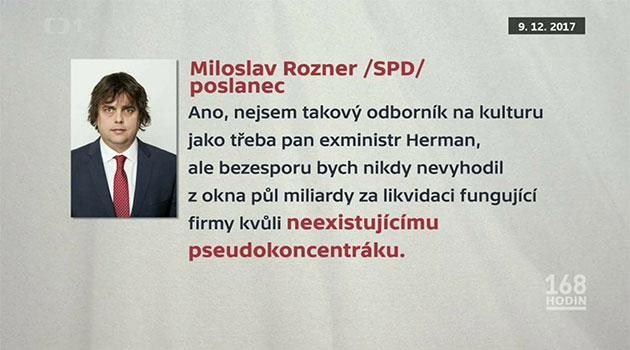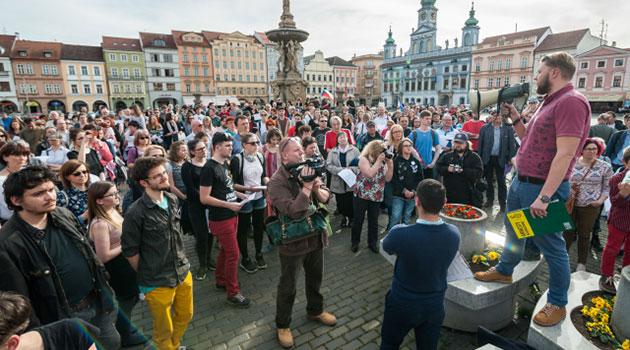Czech Police must re-investigate one MP for Holocaust denial, but head of ultranationalist party will not be prosecuted

Remarks made by Czech MP Miloslav Rozner (“Freedom and Direct Democracy” – SPD) about the WWII-era camp for Romani people at Lety u Písku must be investigated anew by the Czech Police. The Municipal State Prosecutor’s office in Prague has ordered the investigation reopened.
On the other hand, the decision by police to shelve a criminal report against the chair of the SPD, Czech MP Tomio Okamura, remains in effect, according to the prosecutor, as his remarks were not found to have been criminal. Aleš Cimbala, a spokesperson for the prosecutor’s office, has confirmed that decision to Czech Television.
As news server Romea.cz and other media outlets reported previously, police shelved both cases in mid-October saying neither constituted a crime. Rozner used the phrase “non-existing pseudo-concentration camp” when criticizing the state purchase of an industrial pig farm located near a remembrance site to the Romani victims of genocide at Lety.
“The file material was returned through the District State Prosecutor for Prague 4 to the police body in order to continue with a criminal proceedings,” Cimbala said to Czech Television in reference to Rozner’s case. As for Okamura, he erroneously said in January of this year that the former concentration camp at Lety had not been fenced and that people had been free to come and go from it.
Okamura later apologized for claiming the camp had not been fenced but went on to erroneously allege that it had not been guarded most of the time and that people had been able to move freely inside it. He also said the charges against him for Holocaust denial were part of a campaign against the SPD.
The SPD chair said he does not doubt people suffered in the camp but said he has reservations about how the remembrance site is being addressed. The supervising prosecutor said that in his case the police proceeded adequately.
“The police unit proceeded correctly in shelving the matter, because no facts were discovered indicating that a crime had been committed, or rather, suspicion of a crime was not determined and it was not appropriate to deal with the matter in any other way,” Cimbala said. Crime reports against both SPD politicians were filed in February by the chair of the Committee for the Redress of the Roma Holocaust, Čeněk Růžička.
That group of relatives of Romani concentration camp victims and survivors then sought compensation for moral damages. In their view, the remarks by both SPD politicians denied that the Holocaust included Romani victims.
From the history of the concentration camp at Lety u Písku
The original grounds of the facility at Lety u Písku served in the year 1940 as an accommodation facility for construction workers. After that it was used for a disciplinary labor camp on the orders of the Interior Minister of the Government of the Protectorate of Bohemia and Moravia, Josef Ježek, dated 15 July 1940, which was issued on the basis of Czechoslovak Government edict no. 72, “on disciplinary labor camps”, dating from 2 March 1939.
That edict had been promulgated prior to the Nazi occupation, and according to it, “wandering gypsies capable of work and other vagabonds living that same way, professional beggars, persons living from begging done by others (children, etc.), professional gamblers, notorious bums and loiterers, and persons living from dishonorable profits (prostitution, etc.), whether their own or those of others” were to be forcibly interned in the disciplinary labor camps. The first 12 prisoners were sent to the one at Lety on 17 July 1940.
About 10 % of those imprisoned there in 1940 were Romani. On 1 August 1942 the camp was turned into a “Gypsy Camp” and entire Romani families were then forcibly transported there.
The “Gypsy Camp” began to function as a concentration camp on 1 August 1942 and was closed on 4 May 1943. The capacity of the “Gypsy Camp” was increased to house as many as 600 prisoners, but that number was soon exceeded, as during August 1942 more than 1 100 children, men and women were interned there.
The camp was not equipped with the necessary hygienic or other kinds of facilities for so many people. The prisoners frequently had to bathe in the nearby fish pond.
Prior to August 1942, only men had been imprisoned at the facility. Beginning in August 1942, under absolutely unsatisfactory conditions, children and women were brought to Lety and left there to rot as well.
After the big intake in August 1942, those subsequently forced into the camp arrived there just a family or an individual at a time. At least 326 people died directly in the camp at Lety, 241 of them children.
There were 120 victims of the camp buried in a mass grave somewhere near it. Some survivors, however, have given higher numbers for the prisoners who perished at the camp.
Another 540 Lety prisoners perished after being forcibly transported to Auschwitz. A total of two mass transports to Auschwitz happened from Lety.
The first prisoner transport departed for the Auschwitz I concentration camp on 3 December 1942 and numbered 16 men and 78 women who were deemed so-called “asocials”. The second transport resulted in the camp at Lety being practically completely emptied, because it involved 417 prisoners being sent to the Auschwitz II – Birkenau concentration camp.
While the first transport was implemented on the basis of a decree about crime prevention, the second was realized on the basis of Himmler’s decree from 16 December 1942 directing the transport of all Romani people to the Auschwitz concentration camp. The remaining 198 Lety prisoners were then relocated to the “Gypsy Camp” at Hodonín u Kunštátu (the so-called “Žalov” site) or to internment camps in Pardubice and in Prague.
